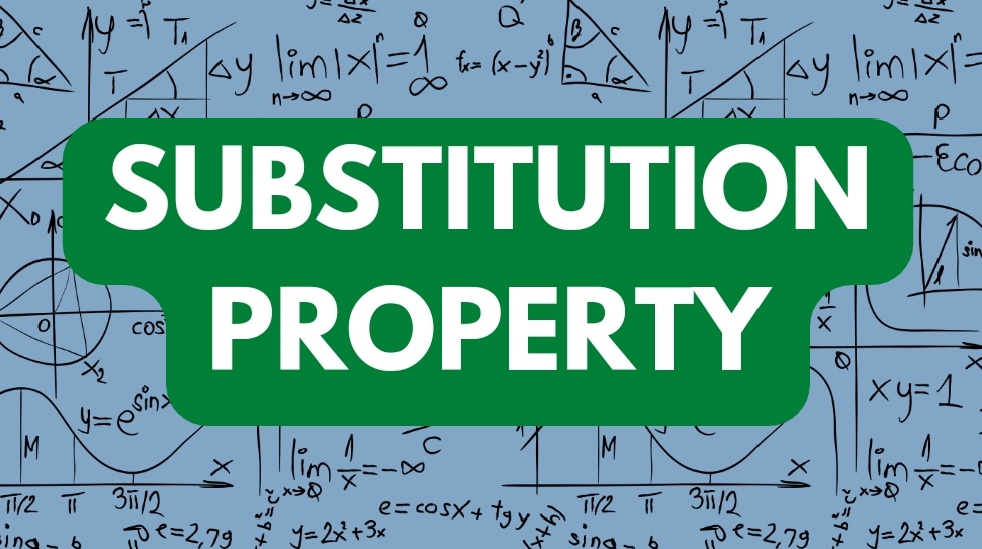
The Substitution Property of Equality in mathematics states that if two quantities are equal, you can substitute one for the other in any expression without changing the equality. This property is fundamental in algebraic proofs and solving equations. For example, in a = b, substituting b for a yields b = b, reaffirming equality.

What is Substitution Property?
The substitution property is a fundamental concept in mathematics, particularly in algebra and logic. It states that if two things are equal, one can be substituted for the other in any expression or equation without changing the truth value of that expression or equation.
In formal terms, the substitution property can be expressed as follows:
- In Algebra:
If (a = b), then (a) can be replaced by (b) in any expression or equation. For example:
- If (x = 5), then in the equation (2x + 3), we can substitute (x) with 5, yielding (2(5) + 3 = 13).
- In Logic:
If a proposition (P) is equivalent to proposition (Q) (P ≡ Q), then (P) can be substituted for (Q) in any logical formula.
The substitution property ensures that the equality or equivalence relationship is preserved across different contexts, making it a powerful tool for simplifying and solving equations and logical statements.
Substitution Property of Equality
The Substitution Property of Equality is a specific application of the substitution principle within the context of equality. It states:
If two quantities are equal, then one can be substituted for the other in any expression or equation.
In formal terms, it can be written as:
- If ( a = b ), then in any expression or equation where ( a ) appears, ( a ) can be replaced with ( b ).
This property is crucial for solving equations and simplifying expressions in algebra. Here are some examples to illustrate how it works:
Examples:
- Substituting in an equation:
If ( x = 4 ) and the equation is ( 3x + 2 ):
- We can substitute ( x ) with 4: ( 3(4) + 2 = 12 + 2 = 14 ).
- Using in a proof:
Given:
- ( a = b )
- ( a + c = d ) By the Substitution Property of Equality:
- Since ( a = b ), we can replace ( a ) with ( b ) in the second equation: ( b + c = d ).
- Simplifying expressions:
If ( y = 7 ) and we have the expression ( y^2 + 3 ):
- Substitute ( y ) with 7: ( 7^2 + 3 = 49 + 3 = 52 ).
This property is fundamental in algebra because it allows for the manipulation and transformation of equations to isolate variables and solve for unknowns.
Substitution Property Examples
Here are some examples illustrating the Substitution Property of Equality in different contexts:
Example 1: Solving an Equation
Suppose we have the equations:
[ x = 3 ]
[ y = 2x + 5 ]
To find the value of ( y ), we can substitute ( x ) with 3 in the second equation:
[ y = 2(3) + 5 = 6 + 5 = 11 ]
Example 2: Substituting in an Expression
Given:
[ a = 4 ]
[ b = a + 7 ]
To find the value of ( b ), we substitute ( a ) with 4:
[ b = 4 + 7 = 11 ]
Example 3: Using Substitution in a Proof
Given:
[ x = y ]
[ x + z = w ]
Since ( x = y ), we can replace ( x ) with ( y ) in the second equation:
[ y + z = w ]
Example 4: Simplifying an Expression
If:
[ m = 8 ]
[ n = m^2 – 4 ]
To find the value of ( n ), we substitute ( m ) with 8:
[ n = 8^2 – 4 = 64 – 4 = 60 ]
Example 5: Substituting in a Real-world Context
Suppose the cost ( C ) of buying ( n ) apples at $2 each is given by:
[ C = 2n ]
If ( n = 10 ) (i.e., you buy 10 apples), you can find the total cost by substituting ( n ) with 10:
[ C = 2(10) = 20 ]
These examples demonstrate how the Substitution Property of Equality is used to solve equations, simplify expressions, and apply mathematical concepts to real-world scenarios.
What is the Principle of Substitution in real estate?
The Principle of Substitution in real estate is a key appraisal concept that helps determine the value of a property. This principle states that the value of a property is influenced by the cost of acquiring a similar property with the same utility and desirability. In essence, a rational buyer will not pay more for a property than the cost of purchasing a comparable substitute property that offers the same benefits and features.
Key Points of the Principle of Substitution:
- Comparable Properties: The value of a property is determined by the prices of similar properties that have recently sold or are currently on the market. These properties should have similar features, such as size, location, condition, and amenities.
- Market Comparison: Buyers will compare properties and choose the one that provides the best value for their money. If two properties offer the same utility and one is priced lower, the buyer will choose the lower-priced property.
- Price Ceiling: The price of a property is effectively capped by the cost of acquiring a comparable substitute. This principle helps prevent properties from being priced excessively higher than similar properties in the market.
- Economic Reasoning: The principle relies on the assumption that buyers act rationally and seek to maximize their utility. They will not pay more for a property if they can obtain a similar one for less money.
Example:
Imagine a neighborhood with several similar houses. House A is listed for $300,000. House B, which is almost identical to House A in terms of size, location, and features, is listed for $280,000. According to the Principle of Substitution, a rational buyer would prefer to purchase House B for $280,000 rather than House A for $300,000, because House B offers the same utility at a lower cost.
Application in Appraisal:
When appraisers evaluate a property, they use the Principle of Substitution to determine its market value. They compare the subject property to recent sales of comparable properties, considering adjustments for any differences. This comparison helps appraisers arrive at a fair and objective estimate of the property’s value.
In summary, the Principle of Substitution ensures that property values are kept in check by the availability of comparable alternatives, reflecting the competitive nature of the real estate market.
Principle of Substitution Example
Here’s an example to illustrate the Principle of Substitution in real estate:
Scenario:
Imagine you are looking to buy a house in a neighborhood where several similar properties are available. You find three houses that meet your criteria: House A, House B, and House C.
- House A:
- Price: $350,000
- Size: 2,000 square feet
- Features: 4 bedrooms, 3 bathrooms, updated kitchen, and a finished basement
- House B:
- Price: $340,000
- Size: 2,000 square feet
- Features: 4 bedrooms, 3 bathrooms, updated kitchen, and a finished basement
- House C:
- Price: $360,000
- Size: 2,000 square feet
- Features: 4 bedrooms, 3 bathrooms, updated kitchen, and a finished basement
Applying the Principle of Substitution:
As a rational buyer, you would consider the Principle of Substitution, which suggests that you should not pay more for a property than the cost of acquiring a similar property with the same utility and desirability.
In this scenario:
- House A and House B offer the same utility (same size, features, and amenities), but House B is priced lower at $340,000 compared to House A at $350,000.
- House C also offers the same utility but is priced higher at $360,000.
Based on the Principle of Substitution, you would likely choose House B, because it provides the same benefits and features as House A and House C but at a lower cost.
The Principle of Substitution ensures that property values are kept competitive. It prevents properties from being sold at prices significantly higher than comparable alternatives. This principle helps maintain a balanced real estate market where buyers are motivated to seek the best value for their money, and sellers are encouraged to price their properties competitively.
Principle of Substitution in Real Estate: What it Is & How it Works
The Principle of Substitution in real estate is a fundamental appraisal concept stating that a property’s value is determined by the cost of acquiring a comparable substitute with similar utility and desirability. Essentially, a rational buyer will not pay more for a property than what it would cost to buy an equally desirable alternative.
How It Works:
- Comparison of Similar Properties: Appraisers identify comparable properties (known as “comps”) that have recently sold or are currently listed in the market. These properties should be similar in terms of size, location, condition, and features.
- Market Price Influence: The prices of these comparable properties set a benchmark for what buyers should be willing to pay. If similar properties are available for less, the subject property’s price must align with these to attract buyers.
- Rational Decision-Making: Buyers compare available options and choose the property that offers the best value. If two properties are similar but one is cheaper, the buyer will opt for the less expensive one, reinforcing competitive pricing.
Example:
If two houses, each with 2,000 square feet, 4 bedrooms, and similar amenities, are listed at $350,000 and $340,000, buyers will favor the $340,000 house. This preference keeps property prices competitive and in line with market values.
In summary, the Principle of Substitution ensures fair pricing by leveraging the availability of comparable properties, maintaining market balance, and guiding buyers and sellers in making informed decisions.
Read more: Plottage in Real Estate Definition – Value, Increment
Difference between transitive and substitution properties
The transitive and substitution properties are both fundamental concepts in mathematics, but they serve different purposes and are used in different contexts. Here’s a breakdown of their definitions and differences:
Transitive Property
Definition: The transitive property states that if one quantity is equal to a second quantity, and the second quantity is equal to a third quantity, then the first quantity is also equal to the third quantity.
Formal Statement: If (a = b) and (b = c), then (a = c).
Example:
- If (x = y) and (y = z), then (x = z).
Substitution Property
Definition: The substitution property states that if two quantities are equal, one can be substituted for the other in any expression or equation without changing the truth value of that expression or equation.
Formal Statement: If (a = b), then (a) can be replaced by (b) in any expression or equation.
Example:
- If (x = 3) and the expression is (2x + 4), substituting (x) with 3 gives (2(3) + 4 = 10).
Key Differences
Purpose:
- Transitive Property: Used to establish a direct relationship between three quantities based on equality.
- Substitution Property: Used to replace one quantity with another equal quantity in an expression or equation.
Application:
- Transitive Property: Primarily applied in logical arguments and proofs to show that two distant quantities are equal.
- Substitution Property: Applied in simplifying expressions and solving equations by replacing variables with known values or other expressions.
Context:
- Transitive Property: If (a = b) and (b = c), then the relationship (a = c) is concluded directly.
- Substitution Property: If (a = b), (a) can be substituted by (b) wherever (a) appears in an equation or expression.
Examples in Context
- Transitive Property Example:
- If (5 + 3 = 8) and (8 = 4 \times 2), then (5 + 3 = 4 \times 2).
- Substitution Property Example:
- If (x = 7) and the expression is (2x + 5), substituting (x) with 7 gives (2(7) + 5 = 19).
In summary, the transitive property links equalities in a chain to show direct equality between distant terms, while the substitution property allows one equal term to replace another within mathematical expressions or equations.
What is Substitution Property in Maths?
The Substitution Property in mathematics is a fundamental principle that allows one quantity to be replaced with another equal quantity within an expression or equation without altering the expression’s value or the equation’s truth. This property is essential in solving equations and simplifying expressions.
Definition
Substitution Property of Equality: If two quantities are equal, one can be substituted for the other in any expression or equation.
Formal Statement
If ( a = b ), then in any expression or equation where ( a ) appears, ( a ) can be replaced with ( b ).
Examples
Simplifying Expressions:
- Given: ( x = 4 )
- Expression: ( 3x + 5 )
- Using the substitution property, replace ( x ) with 4: ( 3(4) + 5 = 12 + 5 = 17 )
Solving Equations:
- Given: ( y = 2x )
- And: ( x = 3 )
- Substitute ( x ) with 3 in the first equation: ( y = 2(3) = 6 )
Using in Proofs:
- Given: ( a = b )
- And: ( a + c = d )
- Substitute ( a ) with ( b ) in the second equation: ( b + c = d )
Real-World Application:
- Suppose the cost ( C ) of buying ( n ) apples at $2 each is given by ( C = 2n )
- If ( n = 10 ), substitute ( n ) with 10: ( C = 2(10) = 20 )
Importance
The substitution property is crucial for:
- Solving algebraic equations: It allows for isolating variables and finding their values.
- Simplifying expressions: It helps reduce complex expressions by substituting known values.
- Proving mathematical statements: It ensures the validity of logical steps by substituting equal quantities.
In summary, the substitution property in mathematics ensures that equal quantities can be interchanged within expressions or equations, facilitating problem-solving and simplification processes.
What is the Substitution Property in Geometry?
The Substitution Property in geometry, like in algebra, states that if two geometric quantities are equal, one can be substituted for the other in any geometric expression or equation without changing the truth of the expression or equation. This property is essential for proving theorems and solving geometric problems.
Definition
Substitution Property in Geometry: If two geometric figures, angles, or lengths are equal, one can be substituted for the other in any geometric statement.
Formal Statement
If (a = b), then (a) can be replaced by (b) in any geometric equation or expression.
Examples
Using in Angle Measures:
- Given: (\angle A = \angle B)
- And: (\angle A + \angle C = 90^\circ)
- Substitute (\angle A) with (\angle B): (\angle B + \angle C = 90^\circ)
Using in Segment Lengths:
- Given: Segment (AB = CD)
- And: (AB + EF = 10) cm
- Substitute (AB) with (CD): (CD + EF = 10) cm
Using in Triangles:
- Given: Triangle ( \triangle ABC \cong \triangle DEF ) (which implies all corresponding parts are equal)
- Thus, ( AB = DE )
- If ( DE = 5 ) cm, then we can substitute ( AB ) with 5 cm in any related calculations.
Importance
The substitution property is fundamental in geometry for:
- Proving Theorems: It allows for replacing geometric elements with their equal counterparts to simplify proofs.
- Solving Problems: It helps in finding unknown lengths, angles, or other geometric properties by substituting known values.
- Establishing Congruence: It plays a crucial role in proving congruent triangles and other figures by allowing substitution of corresponding parts.
Example in Context
Consider you have two congruent triangles, ( \triangle ABC ) and ( \triangle DEF ):
- Given: ( \triangle ABC \cong \triangle DEF )
- Which means: ( AB = DE ), ( BC = EF ), and ( CA = FD )
- If: ( AB = 7 ) cm
- Then we can substitute: ( DE ) with 7 cm in any geometric calculation or proof involving ( DE ).
In summary, the Substitution Property in geometry ensures that geometric elements equal to each other can be interchanged within geometric expressions or equations, aiding in problem-solving, simplification, and proof construction.
What Does the Substitution Property of Equality State?
The Substitution Property of Equality states that if two quantities are equal, then one can be substituted for the other in any mathematical expression or equation without altering the truth of that expression or equation.
Formally, if ( a = b ), then ( a ) can be replaced by ( b ) in any context where ( a ) appears. This property is fundamental in algebra and ensures consistency and validity in mathematical operations and proofs.
How Does the Substitution Property Work?
The Substitution Property allows replacing equal quantities in any expression or equation without altering its truth. For example, if ( x = 3 ), then ( 2x + 5 ) can be substituted with ( 2(3) + 5 ), resulting in ( 11 ).
This property is fundamental in algebra and geometry, facilitating the simplification of expressions, solving equations, and proving mathematical statements.
What is Direct Substitution Property in Limits?
In limits, the Direct Substitution Property states that if a function ( f(x) ) is continuous at a point ( c ), then the limit of ( f(x) ) as ( x ) approaches ( c ) is simply ( f(c) ). Formally, if ( \lim_{{x \to c}} f(x) ) exists, then ( \lim_{{x \to c}} f(x) = f(c) ). This property simplifies the evaluation of limits for continuous functions without the need for complex calculations.
How Does the Principle of Substitution Benefit a Buyer?
The Principle of Substitution benefits a buyer by providing a benchmark for evaluating the value of properties in the market. It allows buyers to compare similar properties based on features, size, location, and condition.
By considering comparable properties that offer similar utility at different prices, buyers can make informed decisions to maximize value for their investment. This principle encourages competitive pricing among sellers and ensures that buyers pay a fair market price. Ultimately, it empowers buyers to negotiate effectively and avoid overpaying for a property by leveraging the availability and pricing of substitutes in the real estate market.








